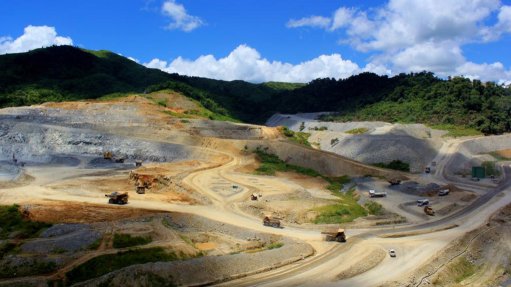
Didipio, Philippines
Photo by: OceanaGold Corp
TORONTO (miningweekly.com) – Triple-listed OceanaGold, which operates gold mines in New Zealand and the Philippines on Wednesday reported a net loss of $2.1-million, or $0.01 a share, owing to declining output and sales at both operations owing to lower grades, which was compounded by higher costs and a stronger New Zealand dollar.
In the three months ended June 30, OceanaGold reported revenue of $127.5-million – a slight drop from the comparable period a year earlier.
The company reported sales of 72 294 oz of gold and 5 173 t of copper at cash costs of $778/oz.
The consolidated second-quarter average gold price received was $1 314/oz compared with $1 311/oz received in the previous quarter. The average copper price received for the quarter was $6 924/t compared with $6 939/t in the previous quarter.
Consolidated output for the quarter was 60 831 oz of gold and 4 706 t of copper.
In the Philippines, the Didipio operation produced 45 266 oz of gold and 11 185 t of copper in the first half of 2014, including 14 786 oz of gold and 4 706 t of copper in the second quarter. The decrease in output from the first quarter was a result of mine sequencing whereby lower-grade ore was mined from Stage 3 of the openpit.
The mill feed was also lower owing to a planned process plant shutdown for maintenance and debottlenecking activities. Production is expected to increase in the third quarter and beyond as the mining operation advances Stage 3 of the openpit into a higher-grade zone of the orebody.
During the quarter, the Didipio optimisation study advanced well and was expected to be complete by the end of the third quarter. The third stage of the tailings storage facility and the water treatment plant were also completed. Debottlenecking activities to achieve the planned 3.5-million-tonne-a-year throughput rate by the end of the year included installing a third-stage tailings delivery pump, building a new tailings line and completing the pebble crusher foundation.
In New Zealand, gold output for the first half of 2014 was 102 133 oz, including 46 045 oz in the second quarter. The quarter-on-quarter decrease was a result of lower-grade ore mined and processed across the New Zealand operations and to lower mill feed at Reefton. Consolidated New Zealand cash costs were $843/oz on 112 334 oz sold in the first half of 2014 and $1 114/oz on 54 548 oz sold in the second quarter. The increase in cash costs from the first quarter was mainly owing to lower sales, a higher New Zealand dollar and a drawdown of ore inventories and gold-in-circuit.
Near the end of the second quarter at the Reefton operation, geotechnical instability of one of the pit walls temporarily affected access in the openpit, resulting in less ore being mined and available for processing. Reduced ore feed would continue in the third quarter while an alternate access in the openpit was being established.
As a result, output at Reefton for the third quarter and full year would be lower than expected. The mine plan had been revised and as a result, the company expected a slight increase in the life-of-mine output at Reefton and the operation to remain cash-flow positive, including rehabilitation costs under its revised mine plan.
"We had a strong start to the first half of the year with free cash flow generation of $71-million, including $22-million in the second quarter, despite a lower quarter for production. The company is well on track to achieve its 2014 guidance and we will continue to strengthen the balance sheet through further debt repayments this year,” OceanaGold MD and CEO Mick Wilkes said.
Despite losing 7% of its value on Wednesday afternoon to trade at C$3.23 apiece, the company’s TSX-listed stock had more than doubled in value since the start of the year.